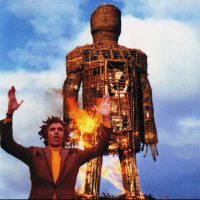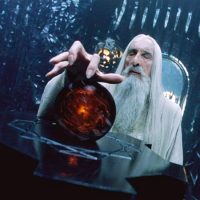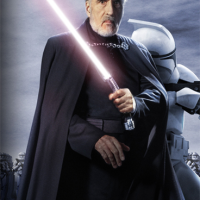
By Robin E. Simmons
“Making films has never just been a job to me, it is my life. Acting is what keeps me going, it’s what I do, it gives life purpose.”
At 6’5”, Sir Christopher Frank Carandini Lee was as imposing a figure on screen as he was in real life. And that wonderfully elegant baritone voice! It was as commanding as it was comforting. Born in London on May 27, 1922, to a Lieutenant in the Royal Rifle Corps and an Italian countess, he was, by the the age of 10, already acting in school productions at Oxford’s Summer Fields prep school.
His film debut came in Terence Young’s 1947 Gothic romance CORRIDOR OF MIRRORS. That same year, he had a brief role in Laurence Olivier’s HAMLET. He also had a small uncredited role in John Huston’s MOULIN ROUGE”(1952) playing the painter Georges Seurat. During the late 1940s and 1950s, Lee appeared in about 30 films, mostly in less-than-memorable adventure pictures.
Even though many older movie buffs first think of Dracula when they remember Lee — he appeared in at least 10 films as Count Dracula — his first role for Hammer Films was not as Dracula but as Frankenstein’s creature in 1957’s THE CURSE OF FRANKENSTEIN.
Peter Cushing, a close friend of Lee’s, starred as the Baron. Together they co-starred in a number of Hammer horror films. HORROR OF DRACULA (1958) was Lee’s first appearance as the blood-sucking Count. More than anything, it solidified a terrifying aura of dark desire for the actor.
Lee also made horror films for Hammer that were not vampire-centric. He was the title character in 1959’s THE MUMMY and 1966’s RASPUTIN, THE MAD MONK. Lee brought Dennis Wheatley, a popular writer of occult thrillers, to Hammer and starred in two adaptations: THE DEVIL RIDES OUT (1967) — considered among Hammer’s best — and TO THE DEVIL A DAUGHTER (1976), which co-starred a seductive 15 year-old Nastassja Kinski. The film made a profit but was denounced by author Wheatley. It would be the studio’s last horror pic.
By some counts, Lee made over 300 film and TV appearances. The online movie site IMDb lists 281 credits.
Lee was a wonderful in Hammer’s THE HOUND OF THE BASKERVILLES (1959) as Lord Henry Baskerville. His old friend Cushing played Sherlock Holmes. Later, Lee played the great detective himself in the non-Hammer SHERLOCK HOLMES AND THE DEADLY NECKLACE. He also played the Sherlock’s brother Mycroft in Billy Wilder’s THE PRIVATE LIFE OF SHERLOCK HOLMES (1970). Lee was grateful to Wilder for giving him a role that rewarded him with a wider range of acting opportunities. During the 1990s, he again played Holmes in two British TV movies. Lee gave Holmes a detached dignity and a formidable physical presence that became iconic within the genre.
A memorable bit — and perfect fit — was Lee’s Compte de Rochefort, chief henchman to Charlton Heston’s Cardinal Richelieu in Richard Lester’s lush adaptation of Alexandre Dumas’ THE THREE MUSKETEERS (1973) and THE FOUR MUSKETEERS. Lee’s one-eyed Rochefort was a man of few words. But his fencing skills were deadly. Lee liked doing his own swordplay and he was very good indeed at “stage fencing.”
But what solidified Lee’s stature as an everlasting global movie star was his participation in the two grandest of all movie franchises: STAR WARS and THE LORD OF THE RINGS (and HOBBIT) films. In J.R.R. Tolkien’s trilogy, Lee played the deceptive and scheming wizard Saruman. Lee reprised the role in the Hobbit movies prequel.
In STAR WARS’ “Episode II – Attack of the Clones” and “Episode III – Revenge of the Sith,” Lee played Count Dooku. No doubt the name meant to invoke Lee’s most famous film character — and the menacing darkness of the actor’s personae. And Lee was magnificent.
Who can forget the wonderful sabre duel between the towering Dooku and the diminutive – fully digitized — Yoda? Guinness Book of World Records sites Lee as being in the “Most Films With A Swordfight.” In a movie duel with Errol Flynn, he almost lost a finger!
Sir Christopher Lee was an actor whose prolific career spanned more than 60 years! His sophisticated but dark onscreen presence embedded itself in generations of filmgoers’ minds and memories during the latter half of the 20th Century and the beginning of the New Millennium. I can find no record of Lee appearing on stage (except when he was ten!). He simply loved acting on film. It was a passion. And he saw no reason to not work merely because he was “old.” Luckily, the film offers kept rolling in. Clearly, even with his vital forces diminishing, he was beloved and still a potent and charismatic force on screen. His popularity only increased.
In TRIAGE, a 2009 film, Lee had a fascinating supporting role as a Spanish psychiatrist with a dark past who helps a Colin Farrell’s war photographer deal with a bad case of “survivor’s guilt.”
My favorite Christopher Lee film is 1973’s THE WICKERMAN. Lee’s portrayal of Lord Summerisle, the seemingly benign leader of a pagan community off the coast of Scotland is bone chilling. As written by Anthony Schaffer and directed by Robin Hardy, this sly, intelligent horror gem goes all the way with the clever premise. Over the years, Lee cited it as his favorite film numerous times. Radically edited on its initial release, the film has recently been restored and the director’s cut is available on Blu-ray.
A good read is Lee’s autobiography “Tall, Dark and Gruesome.” It was first published in 1977 and republished in 1999. In 2004, it was revised and published under the title “Lord of Misrule.”
TCM celebrates the remarkable career of the late Christopher Lee on June 22 with eight of his films: THE MUMMY, THE CURSE OF FRANKENSTEIN, HORROR OF DRACULA, DRACULA PRINCE OF DARKNESS, DRACULA HAS RISEN FROM THE GRAVE, HORROR EXPRESS (a true cult fave), THE THREE MUSKETEERS and THE FOUR MUSKETEERS. For more information go to http://www.tcm.com
The Prince of Wales knighted Christopher Lee on the eve of Halloween, 2009.
R.I.P. Sir Christopher Frank Carandini Lee. Rest assured, you will not be forgotten as long as people love great stories and memorable characters on film.














































